A summarizing review of what has been happening at the crypto markets of the past week. A look at trending sectors, liquidity, volatility, spreads and more. The weekly report in cooperation with market data provider Kaiko.
The last 7 days in cryptocurrency markets:
- Price Movements: Layer 1 tokens and the NFT space are dominating the recent altcoin bull run.
- Volume Dynamics: Despite Binance.US's fundraising woes, the exchange has gained market share versus Coinbase.
- Order Book Liquidity: Price slippage fell sharply for ETH-USD pairs over the past year.
- Derivatives: Funding rates and open interest inched up during the first week of September.
- Macro Trends: The U.S. Dollar plummeted following the Fed's dovish Jackson Hole meeting.
Ethereum and altcoins recover from crash
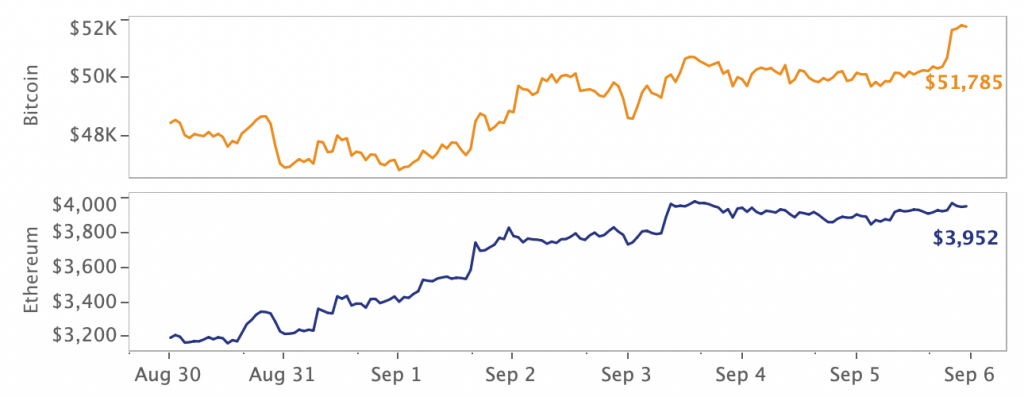
After months of stagnant returns, we are finally seeing a refreshing diversification of price action across the altcoin sector led by Layer 1 protocols and NFT applications. Last week, Cardano (ADA), a Layer 1 protocol that will soon enable smart contract technology similar to the Ethereum network, broke into the top three crypto assets by market cap, surpassing Binance's BNB token which has held the spot since February. Solana (SOL), another Layer 1 protocol, crossed into the top 10 rankings after gaining more than 250% in just 30 days. Ethereum also had a stellar week, albeit less extreme, breaking 3-month highs following its largest daily coin burn since the network's recent hard fork upgrade.
In wider crypto industry news, FTX acquired regulated derivatives exchange LedgerX in one of its most aggressive plays yet for the U.S. market, the SEC is investigating decentralized exchange Uniswap, and the New York Times published an exposé into Bitcoin's energy usage.
Axie Infinity leads NFT hype
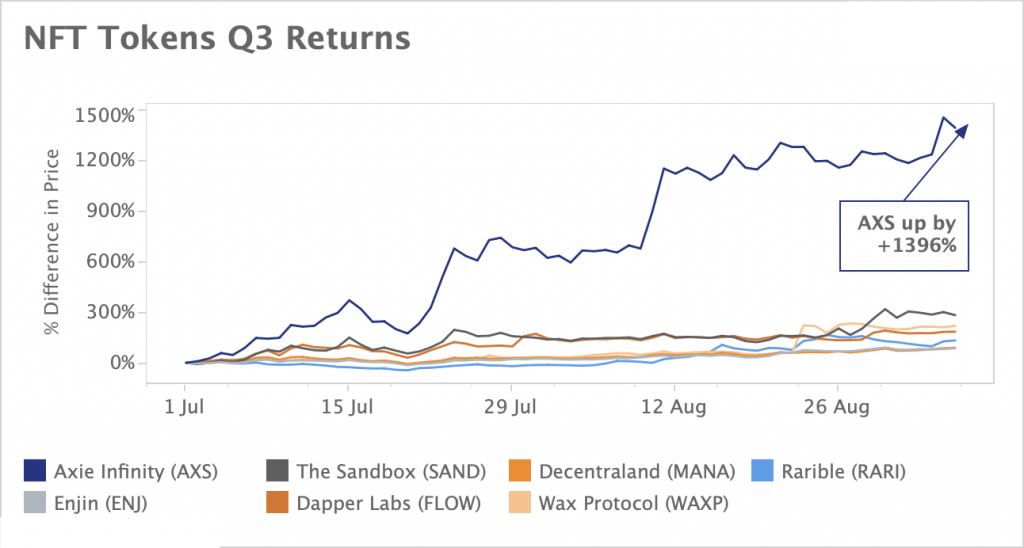
Non-fungible tokens (NFTs) are revolutionizing the multi-billion dollar collectibles and entertainment industries and over the past year have caught the eye of industry heavyweights like Sony, Visa, several luxury fashion brands and scores of celebrities. Monthly volumes on the largest NFT marketplace, OpenSea, exceeded $3.5 Billion in August while all-time sales of art collectibles Axie Infinity and CryptoPunks soared above the billion-dollar mark. Tokens affiliated with NFT marketplaces have tangentially benefitted from the mania.
Axie Infinity’s in-game token AXS tops the returns chart, up a whopping 1'396% in Q3 alone. Other tokens affiliated with projects working in the NFT space such as Dapper Labs (creator of NBA Top Shot), Decentraland (a popular decentralized NFT game), and Rarible (an NFT marketplace) are also well in-the-green this August.
Bitcoin volume trends downward

Despite Bitcoin's recent revival, the 7-day moving average of daily trade volume has trended downwards since reaching an all-time high in late May. Daily volume aggregated across 12 fiat exchanges has hovered between $1 - $2 billion since the start of the summer. From January to May, the average daily volume bounced between $2 - $6 billion. The data suggests that Bitcoin's summer price rally (up 50% since July 1st) is not backed up by the levels of trading interest that propelled the asset to all-time highs earlier this year. Bitcoin saw a slight surge in average volume this August which has since dissipated into September, despite the asset closing the week up 7%.
Which quote asset is dominant?
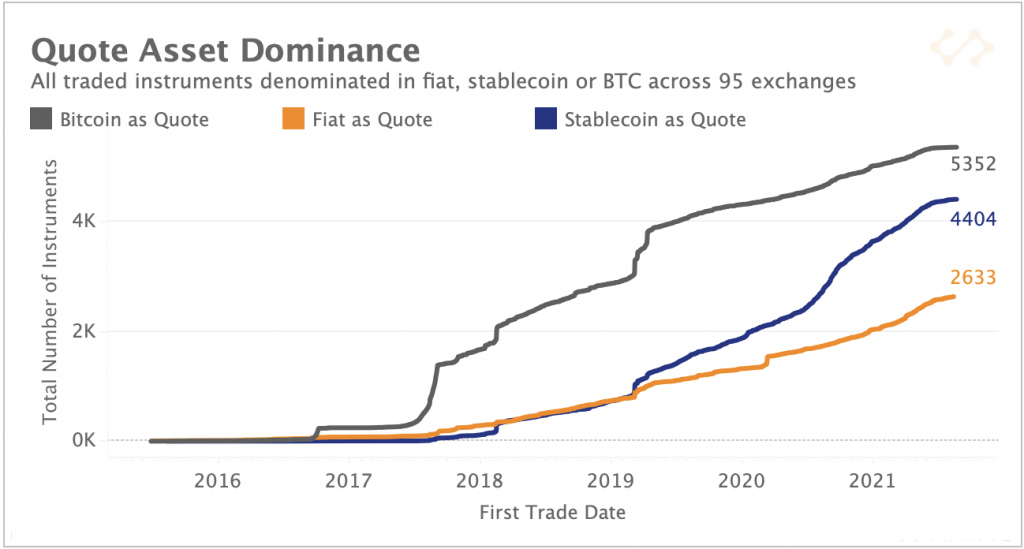
The cryptocurrency market structure is continuously evolving and one way to get an idea of which tokens are dominant is by looking at instrument reference data. Kaiko's public Instrument Explorer maps more than 18'000 spot instruments trading on 95 exchanges and enables filtering by both base and quote asset. Above, we chart the number of traded spot instruments across all exchanges in Kaiko's collection that contain either a stablecoin, fiat currency, or Bitcoin as the quote asset.
We can observe that Bitcoin is still the dominant quote asset, denominating 5'352 traded instruments listed since 2016. However, stablecoins as quote asset has increased rapidly since 2019, and today denominate 4'404 traded instruments and look poised to overtake Bitcoin. Fiat currencies as quote denominate just 2'633 traded instruments, although this sector has undergone consistent growth since 2017 as more exchanges become regulatory complaint. The trends suggest that Bitcoin and stablecoins are today the most structurally important assets to cryptocurrency markets, but that stablecoins are poised to take over.
Funding rates inch upwards into September
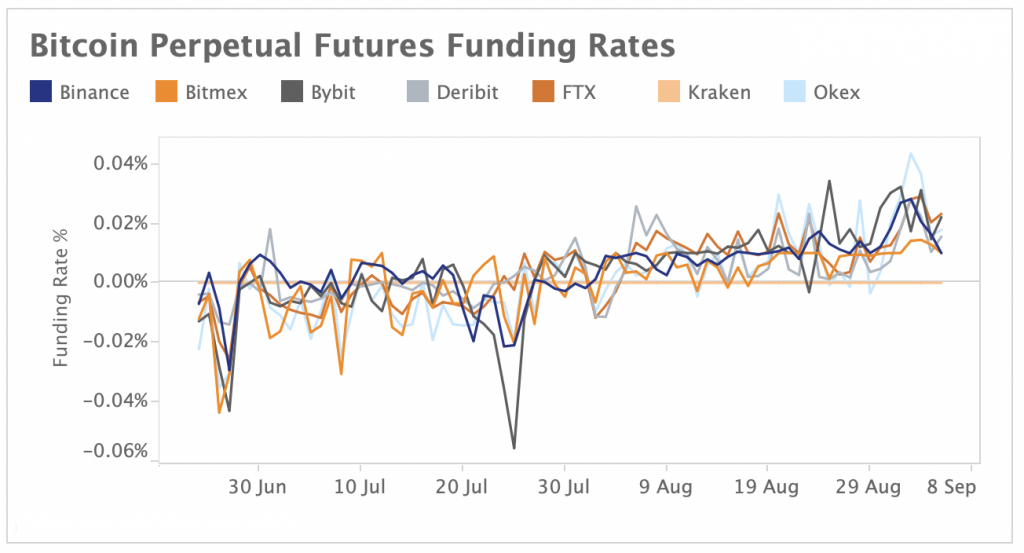
For much of the summer, funding rates were mostly negative as Bitcoin's price remained stagnant and excess leverage from the May price crash exited the system. However, throughout August and into September, funding rates have inched upwards, propelled by renewed bullish enthusiasm for Bitcoin, which broke $50k last week. The funding rate is the mechanism that pegs the perpetual future contract price to the spot price of the underlying asset. When funding rates are positive, longs are paying shorts to keep their positions open, and vice-versa. Positive funding rates suggest bullish bias, which reflects Bitcoin's recent uptrend; however, overall rates are still far lower than the last time Bitcoin broke $50k.

Open interest for Bitcoin perpetual futures contracts has increased more sharply than funding rates and currently sits at 3-month highs. Funding rates are positive (but far less so than previous rallies), while open interest has doubled to more than $10 billion (from $5 billion at the start of the summer). Open interest can be interpreted as an indicator of investor demand and the data suggests traders re-entered markets this August.
The U.S. Dollar plunges following dovish Fed meeting
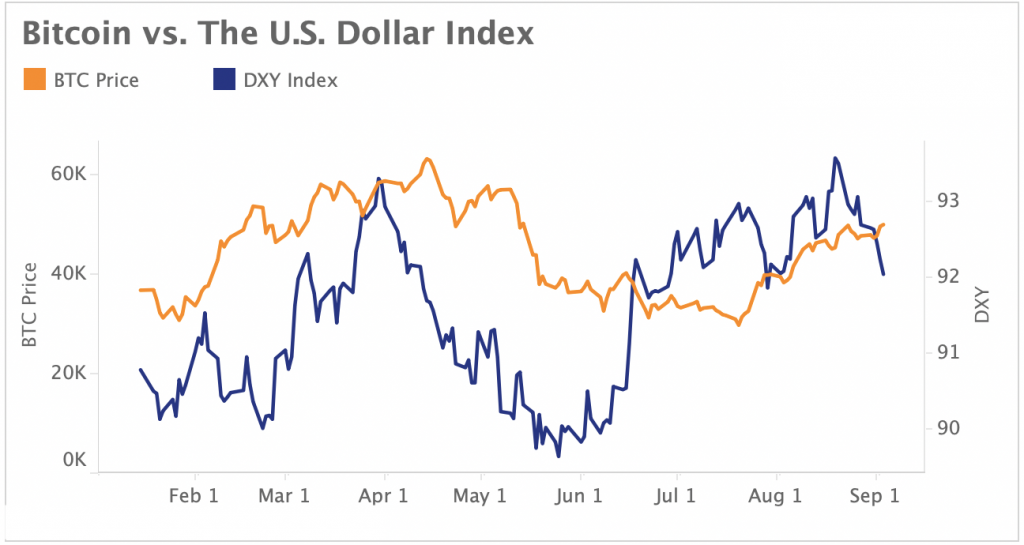
Bitcoin and the U.S. Dollar are again moving in opposite directions from one another. The U.S. Dollar Index (DXY), which tracks the dollar relative to a basket of foreign currencies, is down 0.2% in September following much weaker than expected payroll data for July which is likely going to keep the Fed from scaling back its emergency monetary stimulus measures. Bitcoin held its ground last week, increasing above the $50'000 support level and rising 6.1% in September. The DXY strengthened in August (up 0.6%m/m), hitting a yearly high of 93.57 on Aug 19. However, recent dovish Fed comments and signs of a weakening growth outlook in the U.S. have put downward pressure on the greenback.




